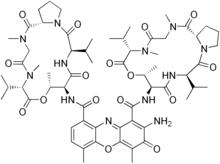Dactinomycin
 | |
 | |
| Clinical data | |
|---|---|
| Trade names | Cosmegen |
| Other names | Actinomycin D 2-Amino- 4,6-dimethyl- 3-oxo- 3H-phenoxazine- 1,9-dicarboxylic acid bis- [(5,12-diisopropyl- 9,13,16-trimethyl- 4,7,11,14,17-pentaoxo- hexadecahydro- 10-oxa- 3a,6,13,16-tetraaza- cyclopentacyclohexadecen- 8-yl)- amide] |
| AHFS/Drugs.com | Monograph |
| MedlinePlus | a682224 |
| Pregnancy category |
|
| Routes of administration | IV |
| ATC code | |
| Legal status | |
| Legal status | |
| Pharmacokinetic data | |
| Protein binding | 5% |
| Metabolism | hepatic |
| Elimination half-life | 36 hours |
| Excretion | Bile[1] |
| Identifiers | |
| |
JSmol) | |
| |
| |
| | |
Dactinomycin, also known as actinomycin D, is a
injection into a vein.[2]
Most people develop side effects.
Dactinomycin was approved for medical use in the United States in 1964.[2] It is on the 2023 World Health Organization's List of Essential Medicines.[4]
Medical use
Actinomycin is a clear, yellowish liquid administered intravenously and most commonly used in treatment of a variety of cancers, including:
- Gestational trophoblastic neoplasia[5]
- Wilms' tumor[6]
- Rhabdomyosarcoma[7]
- Ewing's sarcoma[8]
- Malignant hydatidiform mole[9]
Sometimes it will be combined with other drugs in
chemotherapy regimens, like the VAC regimen (with vincristine and cyclophosphamide) for treating rhabdomyosarcoma and Ewing's sarcoma.[10]
It is also used as a
compensatory hyperplasia that occurs following irradiation.[12]
Side effects
Common
vesicant, if extravasation
occurs.
Mechanism
In
transcription. Actinomycin D does this by binding DNA at the transcription initiation complex and preventing elongation of RNA chain by RNA polymerase.[13]
History
Actinomycin D was the first
Merck Sharp and Dohme
under the trade name Cosmegen.
Research use
Because actinomycin can bind DNA duplexes, it can also interfere with
hydroxyurea
are better suited for use in the laboratory as inhibitors of DNA synthesis.
Actinomycin D and its
7-aminoactinomycin D (7-AAD), are used as stains in microscopy and flow cytometry applications. The affinity of these stains/compounds for GC-rich regions of DNA strands makes them excellent markers for DNA. 7-AAD binds to single stranded DNA; therefore it is a useful tool in determining apoptosis and distinguishing between dead cells and live ones.[18]
Biosynthesis
Actinomycin D is composed of a central
tryptophan dioxygenase, kynurenine formamidase, kynurenine hydroxylase, hydroxykynurenase, and methyltransferase.[22][23]
Early experiments elucidated the presence of non-ribosomal peptide synthetases,paralogs identified between the two clusters.[23]

References
- .
- ^ a b c d e f g h i "Dactinomycin". The American Society of Health-System Pharmacists. Archived from the original on 11 September 2017. Retrieved 8 December 2016.
- ISBN 9780857111562.
- hdl:10665/371090. WHO/MHP/HPS/EML/2023.02.
- S2CID 32560653.
- PMID 6164480.
- PMID 15543019.
- PMID 991106.
- PMID 19818481.
- PMID 19770373.
- S2CID 198317393.
- PMID 4720744.
- PMID 2410919.
- .
- S2CID 84774334.
- PMID 31644085.
- ^ "Drugs@FDA: Dactinomycin". FDA. Retrieved 2023-10-15.
- S2CID 41065740.
- ^ PMID 6129895.
- PMID 13913519.
- PMID 458423.
- PMID 2445729.
- ^ PMID 20304989.
- ^ PMID 10780924.
- ^ PMID 9573200.
- PMID 7683683.
- PMID 8049237.
- PMID 3571237.
- PMID 6203903.
- PMID 10212227.
External links
- "Dactinomycin". Drug Information Portal. U.S. National Library of Medicine.
